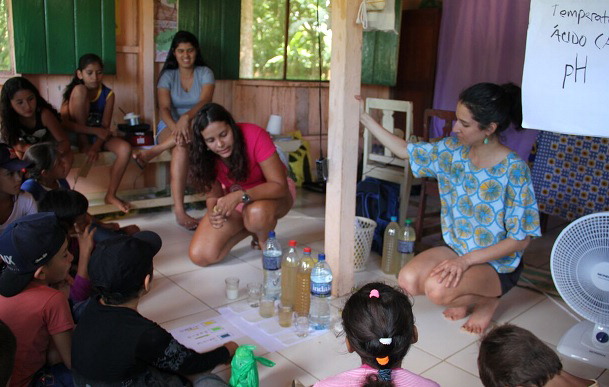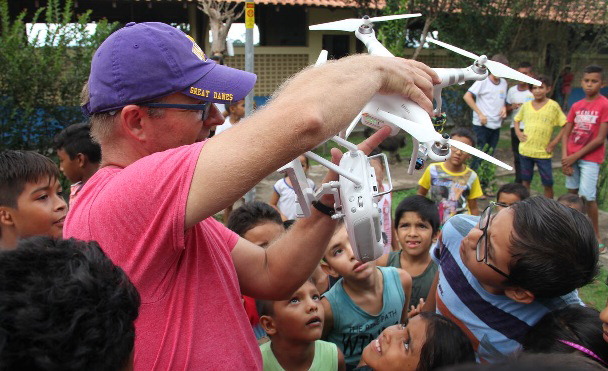Cycle 5 (2015 Deadline)
Integrating dimensions of microbial biodiversity across wetlands and land use types to understand methane greenhouse gas cycling in tropical forests
PI: Jose Mauro Moura (jmaurosm@gmail.com), Universidade Federal do Oeste do Pará
U.S. Partner: Jorge Rodrigues, University of California, Davis
Project Dates: December 2016 - October 2022
Link to Project Video on Facebook
Project Overview
Deforestation is among the most important alterations occurring in tropical systems and is responsible for unprecedented losses of plant and animal biodiversity. However, little is known about the impact of land use change and seasonal inundation of wetlands on microbial biodiversity, especially in the tropics. In previous research, Dr. Moura and his colleagues discovered that soil microbial biodiversity in Amazon rainforest soil is homogenized and reduced by forest-to-agriculture conversion. However, it remains unknown how such changes in microbial biodiversity affect ecosystem functions. This challenge is paralleled by our need to understand, and ultimately manage, the problem of global climate change. This project addresses the intersection of these two questions in the context of biodiversity conservation by asking: “how does the interaction between soil microbial and forest tree biodiversity control cycling of the powerful greenhouse gas methane along gradients of land use and seasonal water inundation in Amazon forests?” To predict the future of methane as a driver of climate change in this system, the researchers will combine novel gas flux measurement instrumentation with cutting-edge molecular microbial ecology. They will address biodiversity and environmental controls on methane production from tropical regions by measuring methane fluxes from a variety of potential sources, including surfaces of tree stems and leaves, soil, and water in forested and deforested areas, as well as upland and wetland areas. Detailed inventories of biodiversity of methane-active vegetation and microbial communities will be performed in the Santarem region of Brazil.
The goals of the project are to advance biodiversity conservation science in Amazônia by (1) quantifying methane-cycling microbial diversity as a function of land use and seasonal inundation, (2) quantifying interactions between methane-cycling microbes and methane cycling, and (3) incorporating knowledge of interactions between methane-cycling microbes and plants into conservation and management plans for mitigating the climate impact of methane emissions. Collaborators from the United States will work with the Brazilian team to analyze and integrate results and ultimately create a model to predict the response of methane cycling to land-use change. This model will not only be useful to a wide community of researchers but will also inform stakeholders and local policy administrators on protecting local biodiversity. The project’s focus on microbial biodiversity as a driver of methane cycling through the twin lenses of land use change and tropical wetlands (the largest natural sources of microbially produced methane to the atmosphere in the world) links development-associated anthropogenic land use change to both biodiversity conservation and climate change feedback. The project will thus bring new knowledge from a novel field (conservation biology for microbes) to our understanding of the impacts of development. Results from this project will provide a basis to inform policy development to simultaneously address problems of biodiversity conservation and management of key economic resource for riverine communities.
 |  | | Students in the Arapixuna District take part in a science-art workshop and learned about ecological concepts. |
Summary of Recent Activities
In the third and fourth quarters of 2021, field activities continued as usual on this project, with Dr. Moura’s group taking regular monthly measurements of methane (CH4) fluxes at their various sites (Varzeas, Arapixuna stream, Salvação, Juá, Terra Preta, Capoeirão, Mata Ciliar, Buriti, Savanna, Pasture, and Primary and Secondary Forest). They also measured tree diameter increments, collected and analyzed biomass from litter traps, tracked daily rainfall data, and collected soil samples to evaluate soil moisture content.
Plans for the first half of 2022 include continuing regular Brazilian-U.S. virtual team meetings and field data collections, as well as installing a plant nursery at Arapixuna’s elementary school. In order to show the community what the PEER team has been accomplishing at the Arapixuna field sites, the PI and his colleagues will also make a presentation on their results and integrate that with an activity with the children at the local elementary school. Although the originally planned Brazilian-U.S. in-person workshop has been cancelled due to ongoing COVID-related restrictions, Dr. Moura reports that augmenting the project database and compiling the data they have archived in different ecosystems will allow them to calculate methane fluxes and describe their correlation with other parameters they measured, such as content of methanogenic bacteria and the hydrological and physical conditions of soil and forest/litter biomass. The final six months of the project will also allow time for the field campaigns for two Master's degree dissertations from students working on the project team. Alan Magalhães will evaluate the effect of induced ground heating conditions on greenhouse gases (CO2 and CH4) fluxes on a variety of Amazon ecosystems. Juliana Sousa will analyze and compare the floristic composition, structure, and dynamics of the natural regenerative stratum of two types of floodplain forest, located in the Arapixuna and Pixuna do Tapará communities near Santarém, Pará. This latter work will be performed within the scope of the PEER project and a new three-year project on methane emissions supported by the U.S. Department of Energy. Dr. Moura also reports that he and his colleagues expect to submit three journal articles for publication in 2022. A no-cost extension has been issued through October 2022 to allow time for the completion of all the planned activities.
Publications
- Machado, Gleice Elen Lima; Medeiros, Matheus Bento; Figueira, Adelaine Michela e Silva; and Moura, José Mauro Sousa de. (2019) Diametric growth in flood forest using dendrometric bands. In: Cristina Aledi Felsemburgh. (Org.). Entrepreneurship and Innovation in Forest Engineering. 1 ed. Ponta Grossa, PR: Atena Editora, vol. 1, pp. 14-24.
- Jati, D. A.; and Moura, J.M.S. (2019) The use of remote sensing techniques and computational modeling in the study of the methane dynamics (CH4) in flooded ecosystems. In: Antonio Humberto Minervino; Tânia Sueli Azevedo Brasileiro. (Org.). Society, Nature and Development in the Amazon. 1 ed ., vol. 1, pp. 192-210.
Back to PEER Cycle 5 Grant Recipients
|





